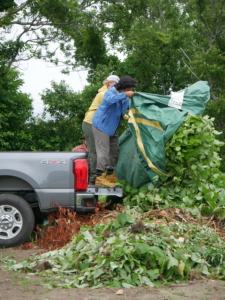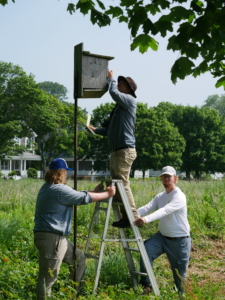The Fishers Island Research and Survey Team (FIRST) wrapped up another busy season of fieldwork this summer. From clearing invasive plants to tracking bats and shorebirds, the team balanced hands-on stewardship with data collection. Their efforts not only improved island habitats right now, but also gathered the kind of information that will guide conservation decisions for years to come.
Much of the data collected this season is still being processed, and FIRST will spend the winter months digging deeper into the results. In the meantime, here’s a look back at what they accomplished this summer.
Invasive Plant Removal
FIRST tackled invasive plants at priority sites across the island, removing the equivalent of eight truckloads of material. Clearing these dense patches gave native plants more room to grow, opened space for natural regeneration, and boosted the overall health of our island’s ecosystems.
Biodiversity Surveys
To understand what species call the island home and how things are changing over time, FIRST surveyed 25 transects of Conservancy land. They set 125 plant plots, 250 pitfall traps, and 125 insect vacuum samples. This wide-ranging effort gives us a clearer picture of the island’s plants and insects and lays the groundwork for long-term monitoring.
Listening for Bats
For seven weeks, bioacoustic monitors recorded bat activity at sites across Fishers Island. The team identified five species, including the Tri-colored Bat and the Northern Long-eared Bat, both listed as threatened or endangered. These findings show that the island plays an important role as habitat for vulnerable bat populations.
 Bluebird Boxes
Bluebird Boxes
Nest boxes were checked weekly throughout the season. Tree Swallows were the primary occupants, and the monitoring helped measure how successful the boxes are as breeding sites. These results will help guide future improvements for nest box programs on the island.
Insects and Knotweed
At nine sites dominated by invasive knotweed, FIRST collected insect samples both before and after mowing. Comparing the two sets of samples will show how insect communities respond to habitat disturbance, giving us insight into how management affects biodiversity in these tough areas.
Building an Insect Collection
The team also processed and identified insect data from the 2024 season and continued building a reference collection. Over time, this catalog will be an invaluable tool for confirming species, studying biodiversity, and tracking changes across the island.
Beyond FI Conservancy work, FIRST students gave back through hands-on projects around Fishers Island, contributing a total of 186 hours of service.![]()
They spent 7.5 hours working with Pollinator Pathways, removing invasives and caring for these community spaces. They dedicated 3 hours to cleaning up the Movie Theater area. At Ferry Park, they put in 18.5 hours removing mugwort, clearing vegetation along the path, and watering newly planted Black Gum trees.
The 2025 season highlighted how much can be accomplished when science and stewardship go hand in hand. While the fieldwork is complete, the story isn’t over… FIRST will continue analyzing this summer’s data through the winter, turning field observations into long-term insights.
Thank you to these students for their energy and commitment, and to the community for supporting this work. Together, we can make sure our habitats and wildlife remain healthy for the future!